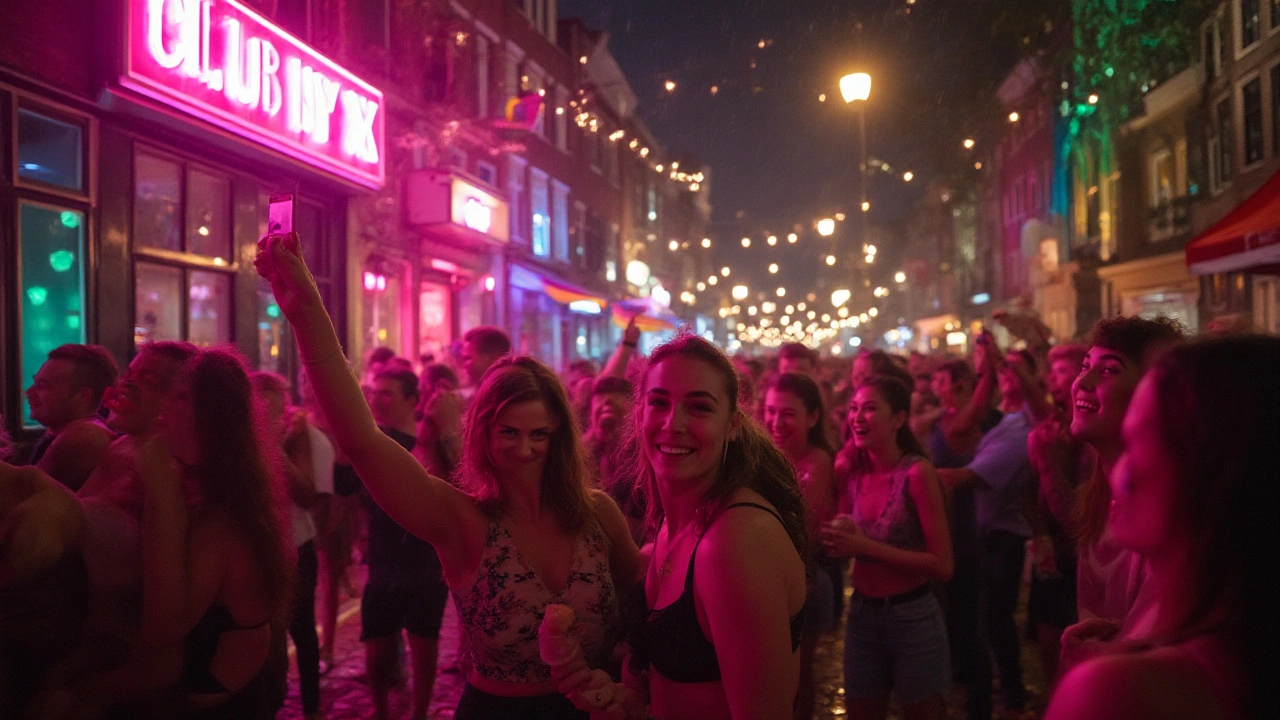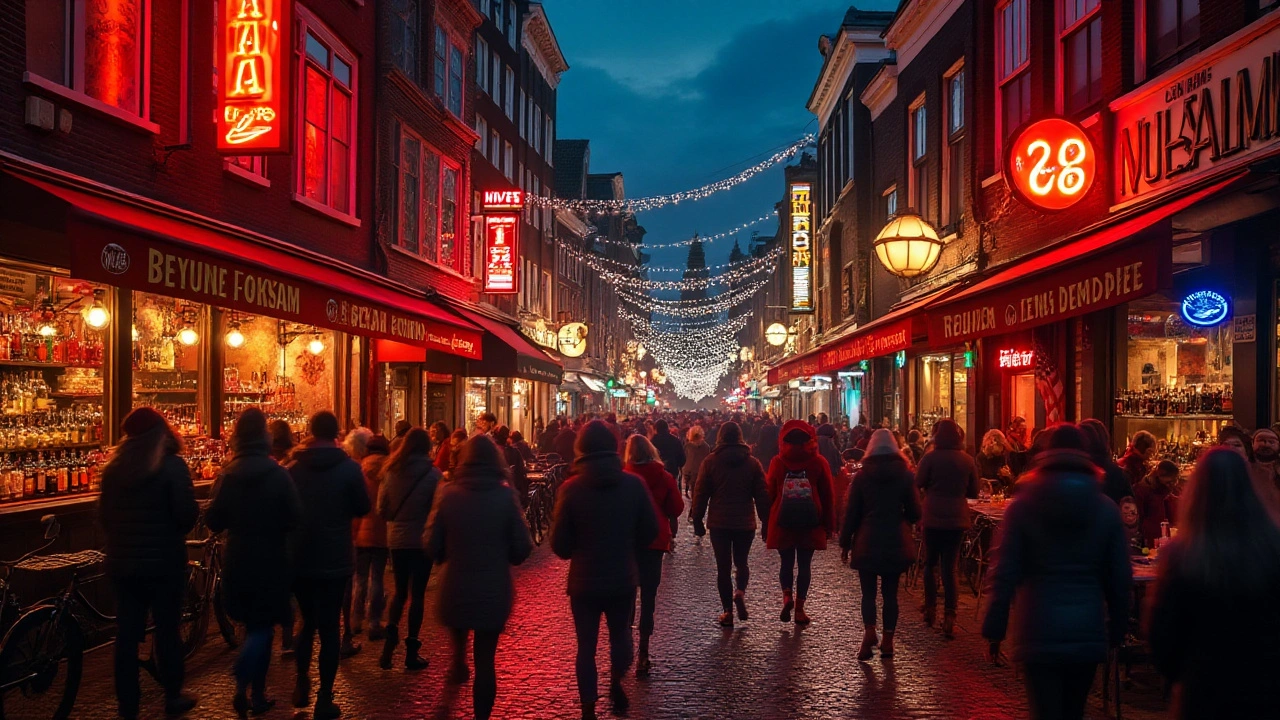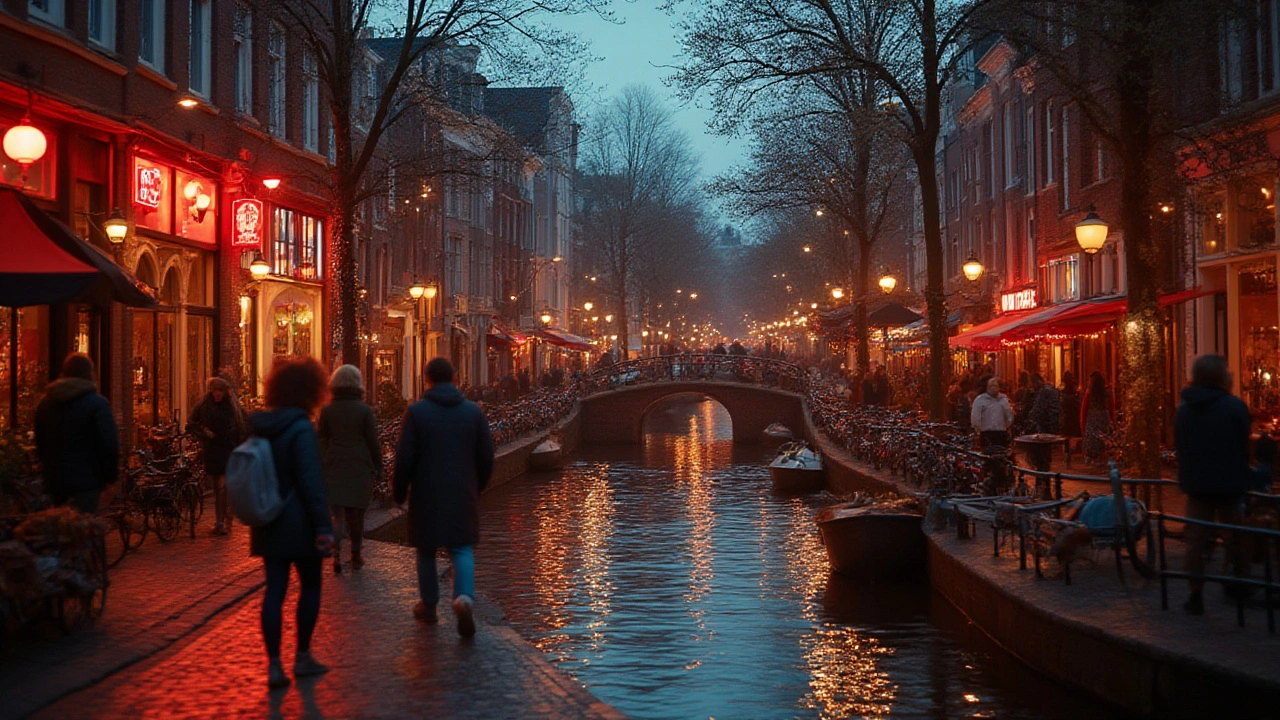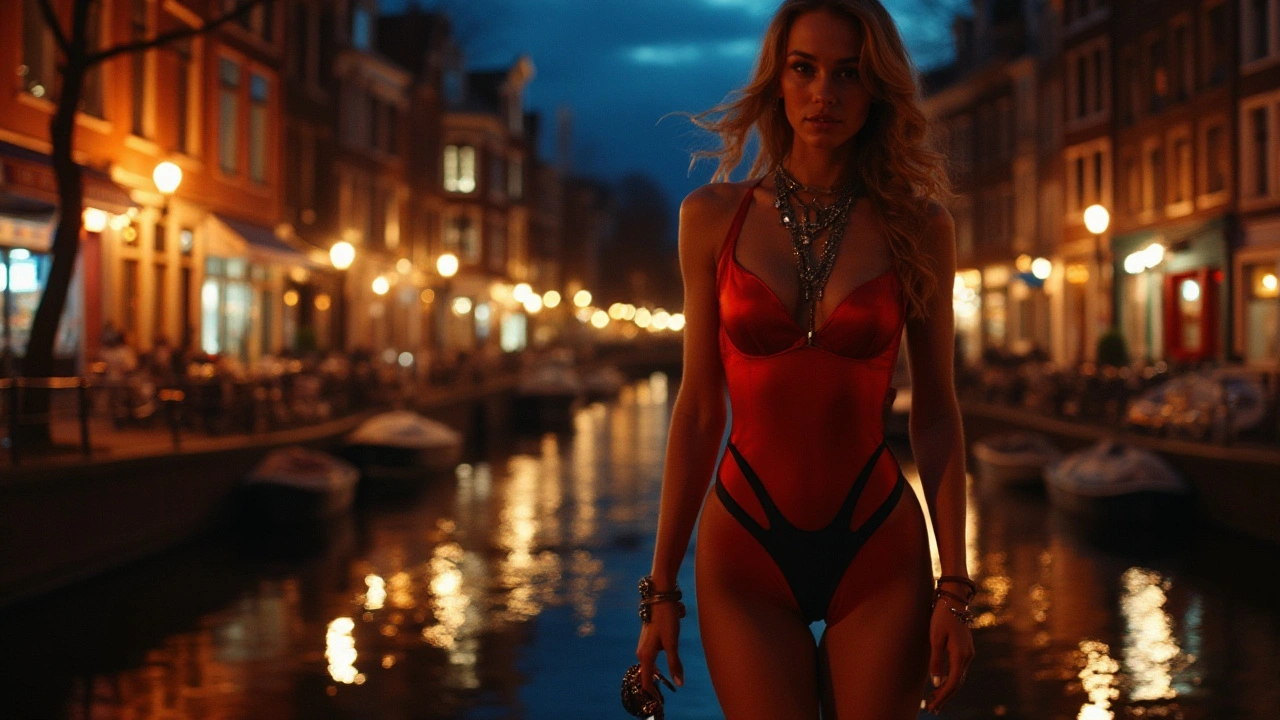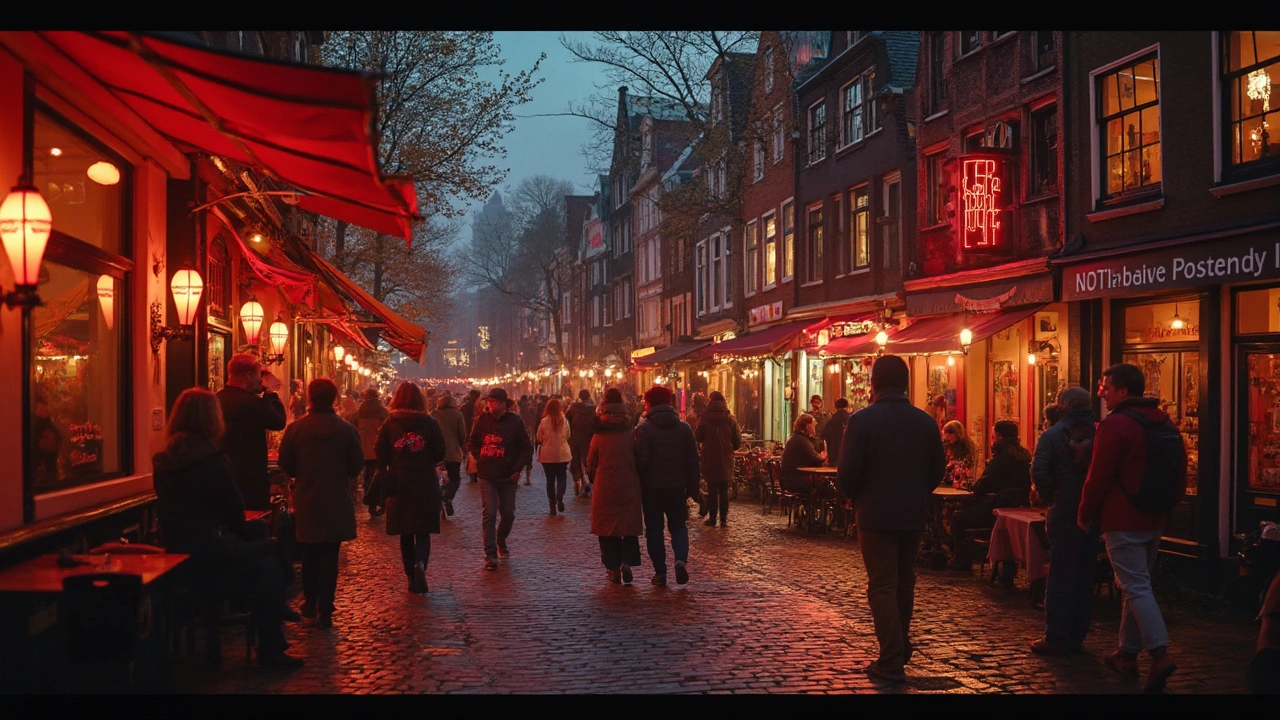
There’s no place quite like Amsterdam’s Red Light District. Step off Amsterdam Centraal, walk ten minutes in almost any direction, and you’ll start seeing the hints: the neon, the reflective windows, the bold crowds. De Wallen is more than its global reputation—this is a proper maze of quirky storefronts, old churches, and alleyways that buzz round the clock.
First thing to know: you can’t take photos of the window workers. Try it, and you’ll get a tap on the shoulder—maybe from security, maybe from a regular. The people working here expect respect, not gawking tourists wielding smartphones.
Stash your valuables somewhere safe. Pickpockets love distracted tourists draped over canals and snapping selfies on the bridges between Oudezijds Voorburgwal and Oudezijds Achterburgwal. Keep your bag zipped and hang onto your phone if you stop for a drink on the edge of the canal.
The vibe changes by the hour. Early evening is packed with walking tours, couples, and curious visitors. After midnight? You’ll see wild bachelor parties stagger out of bars like Cafe Remember and Bulldog Palace, plus every kind of clubber weaving back toward Dam Square. Plan your timing based on the crowd you can handle.
- Stepping into De Wallen: First Impressions
- Navigating the Red Windows and Alleys
- Nightlife Beyond the Obvious: Bars and Cafés
- Staying Safe and Respectful
- Curiosities and Missteps Only Tourists Make
- Must-Know Tips Before You Go
Stepping into De Wallen: First Impressions
Walking into De Wallen—the oldest part of central Amsterdam—hits you differently, even if you’ve seen a hundred travel vlogs about the Amsterdam Red Light District. The energy is real. You’ll find red-lit windows wedged between snack shops, medieval churches rubbing up against cannabis cafés, and the sweet smell of stroopwafels fighting with… well, you’ll notice other less sweet smells too.
The main arteries here are Oudezijds Voorburgwal and Oudezijds Achterburgwal. These parallel canals are where most people start. Want a fast fact? Around 300 red-lit windows and doors operate legally here, making this district the largest and most regulated of its kind in Europe. The first brothels showed up more than 600 years ago, back when sailors rolled in from all over the world and the port was Amsterdam’s lifeblood.
When you step onto these cobbled streets, you’re sharing space with about 40,000 daily tourists in the high season. That means plenty of noise, street performers, and every possible kind of street food (ever tried Dutch frites loaded with mayo and onions?).
| De Wallen Quick Facts | Details |
|---|---|
| Local Name | De Wallen |
| Main Streets | Oudezijds Voorburgwal, Oudezijds Achterburgwal |
| Legal Window Brothels | About 300 |
| High Season Foot Traffic | Up to 40,000 tourists/day |
| Oldest Church Nearby | Oude Kerk, built 1213 |
It’s not all wild parties and window shopping. There are cozy brown cafés like Café ‘t Mandje (open since 1927!) and vintage record shops buried along the smaller alleys. You might spot police on bikes, city volunteers in bright jackets, and, honestly, plenty of locals who treat all this as no big deal.
Here’s something that surprises some folks: Amsterdam locals still live in apartments above the windows. So keep your voice down, don’t block people’s doorways, and if you’re wandering late, don’t be startled if someone tells you to move along. You’re in their everyday reality.
Visually, the contrast is wild: neon reds reflecting off canal water, gothic towers from Oude Kerk peeking through the haze, even street art peering down from crooked brick walls. This is what De Wallen is really about—old clashing with new, locals mixing with tourists, and a freedom that’s been tested (and regulated) for centuries.
Navigating the Red Windows and Alleys
The heart of Amsterdam’s Red Light District, known locally as De Wallen, is a grid of narrow streets crammed with history and neon-lit windows. This spot isn’t just about what’s on show in the glass—they’re packed into alleys like Trompettersteeg, which, at barely a meter wide, is the city’s narrowest street. Here, everything feels close and a bit surreal, especially during peak hours when shoulder-to-shoulder crowds are the norm.
Keep your eyes open for the details. The windows themselves are leased by independent sex workers—Amsterdam law protects their rights, and most work legally with licenses, strict safety checks, and panic buttons. If you’re curious, there’s no pressure just to look. If a worker is interested in meeting you (or anyone), the light above her window glows red, and she’ll usually wave you in. Don’t just stand and stare. Wandering or gawking not only feels rude, it can get you dirty looks from locals.
Finding your way around is easier than you’d think: the Red Light District centers around Oudezijds Achterburgwal. You’ll spot red and blue-lit windows: red signals female sex workers, blue means transgender or male. Most windows are open for business from 11 am into the early hours, but action picks up after dark. Don’t miss the Oudekerkplein, a square anchored by one of the oldest churches in Amsterdam—right next to a ring of windows. That’s Amsterdam for you: centuries-old churches sitting beside the world’s oldest profession.
| Window Color | Who’s There | Typical Hours |
|---|---|---|
| Red | Female sex workers | 11:00–03:00 |
| Blue | Transgender/male sex workers | 14:00–02:00 |
If you’re tempted to check out services, step into one of the Museum of Prostitution’s “Red Light Secrets” booths—a safe, no-pressure way to learn what it’s really like. English is spoken everywhere, but keep your tone casual and nonjudgmental if you do chat with someone in a window. Most deals are quick and clear; if you agree on a price, it’s paid upfront, always in cash. ATMs are everywhere, but watch out for high withdrawal fees on tourist cards.
- No photos or videos—ever. Even pretending will get you in trouble.
- Stay out of the bike lanes and off the tram tracks, especially when lost in the crowds.
- Be aware that police and undercover security are present, keeping things safe but not interfering unless laws are broken.
- If someone offers you drugs on the street, just walk away. Everything legit happens inside licensed venues only.
Prepare for weirdness, humanity, and a side of Amsterdam most people only see on postcards. Respect goes a long way, and knowing how things work saves you from awkward (or expensive) mistakes.
Nightlife Beyond the Obvious: Bars and Cafés
Most folks drop by Amsterdam's Red Light District looking for those red windows, but honestly, that's just one layer of what happens here after dark. If you peel back that first impression, there’s a massive nightlife scene with every flavor of bar and café tucked between alleys and old brick walls. The trick? Don’t just stick to the main drag—wander a block further and you’ll spot the best local hangouts.
A lot of tourists wind up at Café Belgique. This tiny bar is famous for Belgian beers on tap (always at least eight options) and a relaxed vibe where you don’t have to yell over dance music. If craft beer is your thing, also try Delirium Café right at the edge of the district—they stock over 500 types of beer. If you want a classic Dutch brown café (these are like cozy, wood-paneled pubs), hit De Ooievaar. Their jenever, a Dutch gin, is the real deal and comes in dozens of flavors.
For something more wild, Bulldog Palace is practically a rite of passage. It's part coffee shop (the kind that actually sells cannabis, which is totally legal in these parts) and part bar, and it's filled with backpackers swapping stories. They keep a tight security policy, so leave your passport at home but bring an ID.
Looking for something that feels less like a tourist trap? Wynand Fockink is a teeny standing bar that’s been around since 1679, famous for their homemade liqueurs and classic Dutch spirits. Just don’t ask for mixed drinks—it’s straight pours and tradition only. And if you want a late-night snack to soak up the booze, any local will tell you to grab a kroket from FEBO, the weird but fun vending machine snack shop you’ll see glowing all over Amsterdam at midnight.
- Amsterdam Red Light District bars are busiest from Thursday to Saturday, usually after 10pm. Plan to show up early if you want a seat.
- Most cafés and pubs take cards, but smaller spots might still prefer cash—keep a few euros handy.
- Smoking tobacco inside is banned, even in most coffeeshops. Always double check before you light up.
- Public transport runs late, but not all night. Know your last tram or metro if you’re staying outside the city centre.
For a quick glance at what drinks and snacks cost in the district, check this out:
| Item | Average Price (€) |
|---|---|
| Local draft beer (half pint) | 3.50 – 5.00 |
| Cocktails | 8.00 – 14.00 |
| Jenever shot | 3.00 – 4.50 |
| Cannabis coffee shop pre-roll | 5.00 – 10.00 |
| Kroket from FEBO | 2.50 – 3.50 |
If your plan is to see more than just the windows, check out the bars and cafés for a real taste of local nightlife. Just go easy; the drinks are strong, and the nights can last a lot longer than you think.
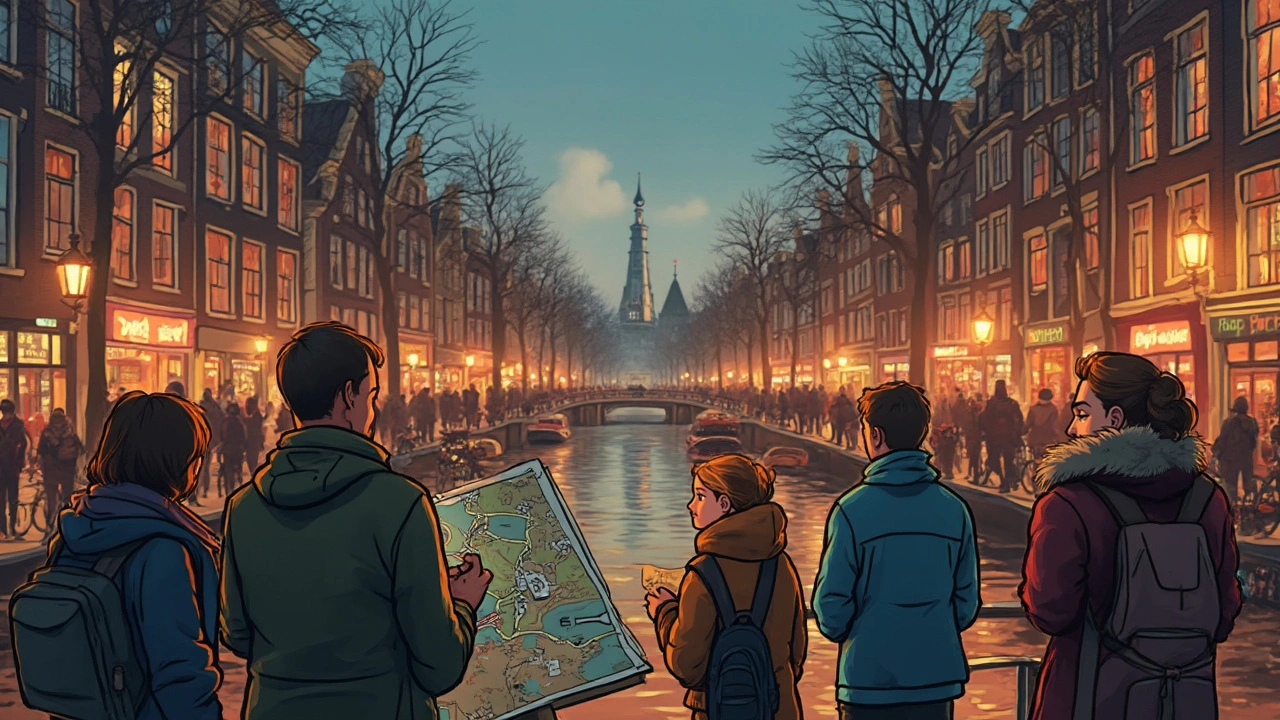
Staying Safe and Respectful
Even though the Amsterdam Red Light District is famous for wild nights, personal safety and respect for others can make or break your experience here. De Wallen is heavily patrolled by police and municipal wardens. According to a 2023 city report, the area sees about 1,200 officers rotate through every week, so you’re never far from help—but that doesn’t mean you can drop your guard.
The locals have some strong feelings about tourist behavior in the Red Light District. As Red Light District info center manager Jeroen Everts told Het Parool in 2024,
“We want visitors to feel welcome, but also to remember they are guests in a working neighborhood, not a theme park.”
So, what’s out? Here’s what not to do:
- Skip the window photos—workers and their security take this seriously.
- Don’t shout, heckle, or bang on doors or windows. It's just rude and gets you kicked out fast.
- Keep the street drinking to a minimum. Open containers are technically banned, and police can fine you €100 on the spot.
- If you’re cycling, walk your bike here. There are bike-free hours in parts of the district, usually evenings from Thursday to Sunday.
If you feel unsafe, look for the neon signs that say “Police” or “Toeristenpolitie” (Tourist Police). Staff at places like Bulldog Palace, and even many bakery cafés, are pretty quick to help if someone’s bothering you.
Petty crime—like pickpocketing and bag snatching—does peak between 11pm and 3am. Check out this snapshot from the 2024 Police Safety Report:
| Time | Type of Incident | Reported Cases (2024) |
|---|---|---|
| 6pm-11pm | Pickpocketing | 120 |
| 11pm-3am | Bag Snatching | 90 |
| 8pm-2am | Minor Assault (fights) | 35 |
Stay with your group, use a crossbody bag, and never leave drinks unattended in clubs or bars. When in doubt, ask locals for advice; most Dutch folks speak solid English and appreciate when visitors try to be considerate.
Curiosities and Missteps Only Tourists Make
First-timers get caught making the same classic mistakes in the Amsterdam Red Light District every night. You see it in the way they clutch cameras, gawk at windows, or wander off the main streets onto tiny side alleys they think are shortcuts. Spoiler: they're not.
Here’s a run-down of tourist stumbles you can easily dodge:
- Trying to take photos of window workers. This will get you in trouble, fast. Locals and security don’t play around with this rule. Snap a pic and you’ll either get a curt warning or a phone dunked in the canal—no joke.
- Ignoring posted rules in coffeeshops. Each spot has its own dos and don’ts posted near the entrance. Asking for 'coffee' and getting annoyed at the answer (it’s weed, plain and simple) happens more than you’d think. Proprietors at places like Coffeeshop The Bulldog are used to confused conversations, but it’s still awkward for everyone.
- Blocking the narrow bridges and alleys for selfies. Locals hate this. Bikes are king here, and if you block the way, you’ll either get dinged by a bell or shouted at in Dutch. Stand to the side before you pose!
- Assuming all window workers are available for chatting. Workers stand in windows to do business, not to entertain groups of tourists. A lot of folks treat it like a museum—don’t be that person staring into windows or lingering awkwardly.
- Falling for fake guides and street hustlers. If someone tries to reel you into a "secret Red Light tour" or says they can get you cheap tickets for Casa Rosso, keep walking. Book your activities through official channels or well-rated apps like Tiqets or GetYourGuide.
Tourists also get turned around by the way De Wallen is organized. Locals know that the best food spots are tucked away from the main strip—people flock to FEBO for Dutch croquettes after the bars close, but it’s easy to miss local favorites like Vlaams Friteshuis Vleminckx for world-class fries with mayo.
| Misstep | % of Tourists |
|---|---|
| Photo attempts of windows | 35% |
| Entering wrong cafes (no weed allowed) | 27% |
| Getting scammed by street hustlers | 19% |
| Bike lane confusion | 41% |
Want to look less like a tourist? Walk with purpose, stay out of bike lanes (they’re everywhere, painted red), and spend five minutes checking a map before you start wandering. The Red Light District is wild, but you don’t have to be clueless to enjoy it.
Must-Know Tips Before You Go
Before you even think about joining the crowds along the Amsterdam Red Light District, there are a few things you need to know if you want your experience to be fun—not embarrassing or risky. This isn’t the place for winging it or acting clueless. Here’s what’ll save you money, stress, and awkward run-ins:
- Cash is king for windows. Most window workers don’t take cards. ATMs in De Wallen are notorious for bad exchange rates, so grab euros elsewhere (Amsterdam Centraal is a good spot) before you wander in.
- Don’t photograph the windows. Just don’t. It’s a fast way to get shouted at, or worse. Even filming out of curiosity will get you in trouble.
- Watch your pockets. Pickpocketing spikes between 10pm and 2am—especially near canals and bars. Amsterdam police logged over 1,100 reported pickpocketing incidents in Centrum in 2024; a lot happened right here.
- Mind the time. Last call at most bars here is around 3am, but the crowd gets rowdier as the night drags on. Don’t linger alone after most places close unless you have company or know the area.
- Respect personal space. Window workers aren’t public property—waving, banging on glass, or hassling them is a great way to get kicked out (or worse: banned from the district).
- Coffee shop ≠ café. If you want a regular coffee, go to a café like Karpershoek or de Kroonprins. If you want to buy cannabis, look for the iconic green coffee shop signs—like at Hunter’s or Green House Centrum.
Here's a quick check-list on what to bring and what to expect based on locals’ advice and stuff they wish tourists would remember:
- Valid ID (checks happen at bars and windows if you look under 25)
- Comfortable shoes—it’s all cobblestones and not many taxis will help after midnight
- A charged phone with Citymapper or Google Maps preloaded; De Wallen is a maze
- Some small bills and euro coins for tips or snacks
To give you a quick look at when it’s safest, rowdiest, or most relaxed, here’s a simple overview of what you can expect at different times:
| Time | Atmosphere | Crowd Type |
|---|---|---|
| 16:00–19:00 | Chill, easy to navigate | Mainly tourists, couples, guided tours |
| 20:00–23:00 | Lively, windows busy | Big mix—locals, tourists, first-timers |
| 00:00–03:00 | Noisy, crowded, watchful for petty theft | Bachelor parties, party crowds |
| 03:00–06:00 | Rough, mostly locals or folks leaving clubs | Late-night stragglers, workers |
Also, public urination is a fineable offense—yes, they have camera-backed urinals and plainclothes cops actually do check. Save the embarrassment (and €150 fine) and find a paid toilet (look for signs in bars or at Centraal).
Plan your route out—night buses and Ubers fill up quickly after 2am. If you’re staying far away, book a ride earlier or find your way to Amsterdam Centraal for safe, well-lit options home. Treat De Wallen like you would any major nightlife center—don’t get too wasted, stick with your group, and keep your wits about you. That’s the difference between a wild story and a nightmare headline.

